Office of the Arts
Council for the Arts
A successful fundraising and programmatic year for the Council for the Arts at MIT was marred only by the death of longtime members Vera List, Joseph Dietzgen '41, Daniel Vershbow '45, and John Kunstadter '49.
Council Standing Committees
Annual Meeting (Patricia Chute, chair). The 30th Annual Meeting of the Council for the Arts at MIT took place on October 24 and 25, 2002, and was focused on the theater arts. The meeting began as council members and guests were treated to a tour of From Page to Stage: A Theatrical Process, a Compton Gallery exhibition highlighting the theater design work created at the Rinaldi Tile Theater Arts Facility.
The council returned to the President's House for cocktails this year on Thursday evening, October 24, after which the group proceeded to Twenty Chimneys at the Stratton Student Center, where dinner was served. Vinie Burrows, actress, playwright and peace activist, was presented with the 2002 Eugene McDermott Award in the Arts (see Special Programs below). She surprised the guests with a stirring speech in the character of Winnie Mandela after accepting the award form Dorothea Endicott.
The Friday morning business meeting began with an address by Larry Benedict, MIT's dean for student life, who spoke of the recent developments in student life, such as the new requirement that all freshmen live on campus.
Michèle Oshima, the new director of special programs in the Office of the Arts, and Nicole Vlado, program coordinator for the Office of Special Programs, were officially introduced to the council, and impressed all present with their plans for the future of special programs.
The new "Arts at MIT" video, produced by director of arts communication Mary Haller, was screened, and associate provost for the arts Alan Brody unveiled the location of the new Performing Arts Laboratory, and challenged the council to raise $500,000 to be used to create a lounge area in the new building for the Arts Scholars and Freshman Arts Seminar Advising program.
One of the highlights of Friday's program was a panel discussion, moderated by council member Robert Schaffer '80, featuring students who were involved in theater while at MIT. Ivi Acuña '96, Charles Armesto '97, Richard Davis '95 Manish Goyal '96, Paulo A. Pereira '95, and Linda Tsang '96 all spoke eloquently of the role that theater played in their lives while at MIT and its relevance in their post-MIT lives. In the author's opinion, this was one of the most inspiring and moving presentations held at any annual meeting and sparked many lively discussions at the luncheon following.
The Gyorgy Kepes Fellowship Prize was presented to Alan Brody, playwright and associate provost for the arts, (see Special Programs below) at the annual meeting luncheon on Friday, October 25 at the Faculty Club. Following the award presentation, those assembled were treated to a reading of a scene from Saturday Memories, one of Brody's works-in-progress, performed by MIT Theater Arts faculty members Michael Ouellette and Janet Sonenberg.
Arts Scholars Committee (Brit d'Arbeloff, chair). Starting this year, the Arts Scholars Program was overseen by the Office of Special Programs
Communications (Pepi Weis, chair). The Communications Committee produced three issues of the council newsletter, Council Currents this year, to great success. Council Currents is written by council members, for council members.
Development (Daniel Vershbow '45, chair). As of this writing (7/11/03) the council has raised a total of $333,063 from council members, and a total of $3,425 from non-member donors.
Grants Program (Bradford M. Endicott '49, chair). This year the Grants Committee received 65 proposals, 43 of which were funded. The entire budget of $90,000 was expended. Highlights of this year's awarded grants include materials support for a mural to be executed by the Latino Students organization in the Stratton Student Center; an installation entitled Traffic Patterns to be exhibited at the Americas Foundation in New York city by MIT student Jennifer Allora; and a production entitled Spunk based on based on the works of Zora Neale Hurston by the Black Theater Guild.
Membership (Bernard G. Palitz '47, chair). As of this writing (July 11, 2003) council membership stands at 109, with six ex officio members and 103 regular members.
The following new members have joined the council since our last President's Report: Barbara Hughey '89, Dawna Paton '77, Ann Chase Allen, Anna Davol, and Philip Palmedo '61.
Special Events Committee. This year's Special Events Committee is planning an excursion to Venice, to take place September 2-7. Stephen Memishian '70 is acting as ad hoc committee chair this year and has been instrumental in the planning that has already taken place. Kathleen Goncharov, curator of the MIT permanent collection, is the commissioner of the American pavilion for this year's Venice Biennale. Kathy will accompany the council members on this trip, as will Peter Houk, artist-in-residence in the MIT Glass Laboratory. Peter will arrange a tour of glassblowing labs on Murano.
Affiliated Committees
List Visual Arts Center (LVAC) Advisory Board (Jennifer Frutchy, chair) The LVAC Board continues to be a valuable group of advisors to the director, Jane Farver. The most exciting news from the List Center this year was the selection of Kathleen Goncharov, List Center staff person as commissioner of the American pavilion for the 2003 Venice Biennale. The artist with whom she worked is Fred Wilson. The LVAC also received an additional allocation of $20,000 from the council for FY2003. These extra funds are to be used for conservation efforts for pieces in the permanent collection.
MIT Museum Advisory Board (Harvey I. Steinberg '54, chair). The search for a new museum director continues. Mary Leen, acting director, has maintained the high level of quality in both exhibitions and educational and community-outreach programs.
Artist-in-Residence Committee (Stephen Memishian '70, chair). The committee was disbanded this year. There is a possibility that the committee will be revitalized, possibly with a focus on fundraising for the artist-in-residence programs.
Special Programs
Since 1980, the council has underwritten MIT's enrollment in the University Membership Program offered by the Boston Museum of Fine Arts. This program provides free admission and discount benefits to all MIT undergraduate and graduate students, as well as ten membership cards for the daily use of MIT faculty and staff.
The Council for the Arts also sponsors a student membership program with the Photographic Resource Center (PRC) at Boston University. The PRC provides a range of programs: exhibitions by national and international photographers and educational programs. MIT undergraduates and graduate students have free unlimited access to the PRC galleries and library and admission to lectures, workshops and other special events at the discounted member price. They are also be able to enter their work into the juried members' exhibition.
The free-ticket program with the Boston Symphony Orchestra continued this year. MIT students can obtain, with their student ID, free admittance to an average of 24 concerts per year. Similar programs have been established with other Boston-area orchestras, such as the contemporary music ensembles Collage New Music and the Boston Modern Orchestra Project (BMOP).
The successful Student Performing Arts Excursions Series continued, with hundreds of MIT students signing up to attend performances by the Alvin Ailey and Mark Morris dance troupes, world music artists such as Huun Huun Tur, the Tuvan Throat Singers; Salif Keita, the Malian singer; the Master Dancers of Bali; and theatrical performances of Medea, Our Town, and Twilight by Anna Deveare Smith. Classical music was not forgotten, as tickets were distributed for the Handel & Haydn Society's performance of Bach's Mass in B Minor, and the Cantata Singers' performance of Haydn's The Creation.
The Gyorgy Kepes Fellowship Prize was presented by Dorothea Endicott to Alan Brody at the annual meeting luncheon on Friday, Oct. 25. At the annual meeting dinner at the Stratton Student Center on Thursday, October 24, the Eugene McDermott Award was presented by Dorothea Endicott (McDermott Award committee chair) to Vinie Burrows, actress, playwright and activist. Ms. Burrows returned to campus in February to perform with MIT students in the African American Living Museum, and in March to present her moving one-woman show entitled Rose McClendon: Black on the Great White Way in Kresge Little Theater. Alan Brody served as director of the production; Ms. Burrows is the playwright.
At the Institute Awards Convocation on May 13, associate provost for the arts Alan Brody presented the Laya and Jerome B. Wiesner Student Art Awards to MIT's Gamelan Galak Tika for music, the MIT Bhangra Club for dance, Sangita Shresthova (G) for dance and choreography, and Daniel Katz '03 for theater arts. The Louis Sudler Prize was presented to Alison Wong '03 for her accomplishments in the visual arts.
A relatively recent program, the Pilchuck Scholarship was established by the council at the request of the MIT Glass Lab. One MIT student per year is chosen to attend a summer session at the Pilchuck Glass School outside Seattle, WA. The council contributes half of the tuition; Pilchuck provides the balance. This year, the scholarship was awarded to Whitney Cornforth.
More information about the Council for the Arts can be found at http://web.mit.edu/arts/council/.
Arts Communication
In the 14th year of the Office of the Arts, Arts Communication staff continued to maintain and increase awareness of the arts at MIT both within and outside the Institute by publishing and distributing up-to-date information on MIT arts events and exhibitions; actively promoting arts-related activities, programs, and people at MIT; and working with the Admissions Office to inform prospective students about the arts at MIT.
Internal (MIT)
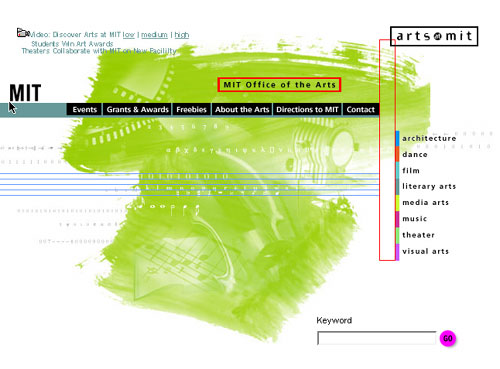 Arts at MIT home page on the web. |
The latest installation of the Arts at MIT web site (launched last year), generated increased traffic, attention and email to the Office of the Arts from around the world. Lynn Heinemann fielded the numerous questions and comments, which included inquiries from potential applicants about campus visits and MIT arts opportunities, questions from outside artists about the availability of exhibition spaces and dark rooms and numerous other queries.
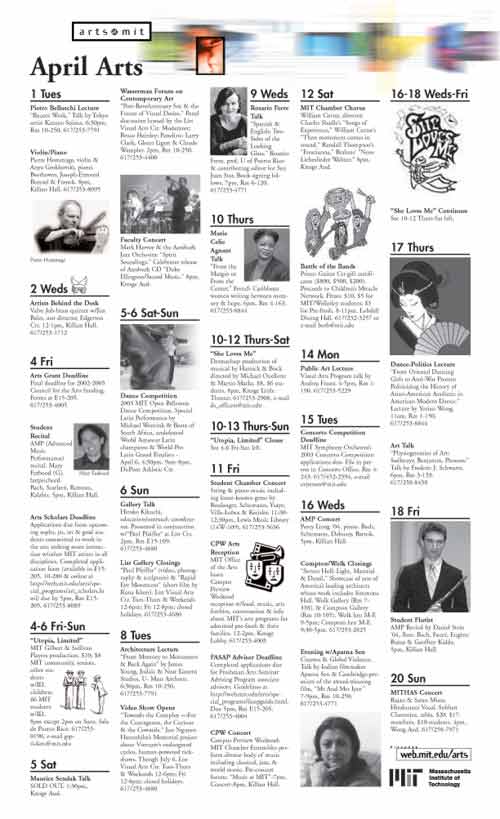 April-at-a-Glance arts mailing. |
In March 2003, the "Month-at-a-Glance" pages (monthly listings of MIT's arts events and activities) became a stand-alone calendar not connected with Tech Talk. These calendars, now printed on arts@MIT letterhead, were published by Arts Communication and mailed monthly to 609 individuals at their request.
Copies of the "Discover the Arts@MIT" DVD were sent to the 220 regional chairs of MIT's Education Council. The DVD was also encoded into a streaming media format, then linked to the Admissions Office's admitted student web site and to the home page of the arts@MIT web site. The nine-minute piece continued to generate positive feedback from both within and outside of MIT.
Haller once again hosted an arts reception for prospective students during Campus Preview Weekend. The event, which took place in the Kresge Lobby, included performances by MIT student musicians and gave accepted applicants for the Class of 2007 a chance to meet faculty and current students and obtain information on MIT arts programs and opportunities. The arts were also represented once again at the campus-wide Activities Midway at the start of the fall semester.
As part of an MIT communications workshop entitled, "Tools for Developing and Using Effective Messages," Haller was one of three panelists invited to present their communication programs as examples of "best practices." Over 70 MIT communicators attended the workshop, at which Haller presented the arts@MIT brochure, web site, DVD and related materials, and described the goals and target audiences of each one.
Lynn Heinemann maintained and publicized arts events on MIT's electronic web-based events calendar and maintained the arts web site, updating calendar listings, publishing each week's Tech Talk arts stories and creating new links. The LED sign in Building 16, written and programmed by Heinemann, continues to generate attention with announcements of MIT arts events and activities. Heinemann also continued to produce the weekly "Arts Hotline" (617-253-ARTS).
Arts Communication handled the announcements and distribution procedures for a program offering free tickets to concerts by Metamorphosen, held regularly throughout the year.
The Arts-Announce email list, developed especially for those interested in announcements about MIT-related arts, free and discounted ticket offers and information on special MIT arts events, continued to be an effective tool for communication.
Arts Communication continued to oversee ArtsNet, which consists of about 90 campus arts representatives.
Haller represented the arts as a member of the Communications Operations Group (COG) and Information Group.
Student Recruitment and Communication
For the eighth year, MIT's admission application included tear-out postcards for prospective students to use to request information on the arts at MIT and indicate specific arts interests. Postcards were received from 974 individuals and a copy of the Arts@MIT booklet, a postcard about the arts home page on the web, and a "freebie" flyer were sent to each with a letter from Associate Provost for the Arts Alan Brody.
Tech Talk Coverage
For the 14th year, Arts Communication provided text and images for Tech Talk, including six front-page stories. Tech Talk's newly-designed format, inaugurated in February 2003, featured increased arts coverage on the back page "Calendar" and "Editor's Choice" columns, with plentiful use of arts images.
Heinemann was the primary writer; other contributors included Christina Jensen, Haller, members of the News Office staff and members of the MIT arts community.
Special Media Attention
The following are some of the people and projects across the Institute who received external media attention through publicity efforts initiated by Arts Communication:
- "Great Glass Pumpkin Patch" returns to MIT.
- Awarding of the 2002 McDermott Award to activist/actress/writer Vinie Burrows.
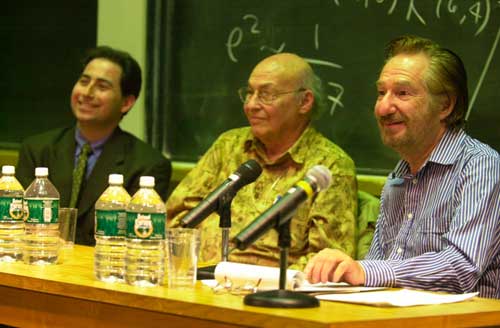 Panelists David Kaiser (assistant professor, Program in Science, Technology, and Society), Marvin Minsky (professor, Media Arts and Sciences), and Edward Fredkin (visiting scientist, Media Lab) (left to right) discuss Feynman's discoveries and personal experiences following a staged reading of QED. Photo by Jina Kim '05. |
- A staged reading of QED, with award-winning actor Jeremiah Kissel portraying Nobel laureate Richard Feynman (SB 1939). The reading, which played to a packed house in Room 10-250, was followed by a panel discussion featuring friends and collaborators of Feynman and a sampling of a new ice cream created in honor of Feynman by Gus Rancatore of Toscanini's.
- The MIT appearances of cartoonist Art Spiegelman, writer Aparna Sen, and artist Cai Guo-Qiang.
- Announcement of the lease-signing between MIT and the Nora Theater and Underground Railway Theater for a new performance space in Central Square.
- Hiring of writer Junot Diaz as associate professor in the Program in Writing and Humanistic Studies.
- List Foundation Fellow Melissa Edoh, who presented a Senegalese drumming concert with Artist-in-Residence Lamine Tourè.
Other Media Attention
Alan Lightman, adjunct professor in the Program in Writing and Humanistic Studies, contributed an essay to the New York Times titled "Art That Transfigures Science," in which he traced the synthesis of science and art from a 1768 painting called An Experiment on a Bird in the Air Pump by Joseph Wright of Derby to recent films and plays like A Beautiful Mind and Copenhagen. "When the science is integrated so that it is a part of the human drama, part of the beauty and mystery of human existence, then science and art have achieved perfect harmony," wrote Lightman.
Research Scientist Karl Iagnemma was featured in the Boston Magazine, the Boston Phoenix and the Boston Globe in conjunction with the publication of his short story collection, On the Nature of Human Romantic Interaction. "Iagnemma has the good sense and lightness of touch to render the rapture of science—and to know when its human parameters matter even more," wrote the Globe's Gail Caldwell in her review of his work.
The Musical Theatre Guild's foray into intergallactic musicals (Star Wars: Musical Edition) generated unprecedented outside interest in an original student production, leading to sold-out houses for each performance. The Boston Herald's take was "Even brainiacs gotta sing and dance sometimes" while the Boston Phoenix wrote, "MIT makes 'Star Wars' sing" calling the show "the kind of entertainment that could happen only at MIT." The Boston Globe praised the effort by the "nerdburgers," writing, "The tap-dancing storm troopers alone are worth the $10 ticket price."
The Cambridge Chronicle profiled List Foundation Fellow Melissa Edoh prior to her January Senegalese drumming concert with Artist-in-Residence Lamine Tourè and other MIT students.
BMOP's (Boston Modern Orchestra Project) American premiere of Professor Tod Machover's Toy Symphony not only captured tremendous local coverage, but generated praiseful stories in the New York Times, the Newark Star-Ledger, Associated Press and National Public Radio's All Things Considered.
Guest performers who caught the attention of local media included the Arditti String Quartet ("the musicians…have a nearly magical ability to make you hear whatever they're playing"—Boston Globe).
A collaboration between internationally renowned choreographer and MIT alumnus Gus Solomons, Jr, and MIT's new Dance Theater Ensemble was featured on WGBH-TV's Greater Boston Arts. The environmental work, set to an original musical score composed and performed by assistant professor of music Brian Robison, was originally performed in September 2002 in the Rotch Architecture Library.
A Boston Herald review of Center for Advanced Visual Studies fellow Elizabeth Goldring's retinal prints and poetry at the Compton Gallery praised her "lyrical words and vision" and how she "celebrates the human connections made possible by the existence of language or art—or the two intertwined."
The MIT Museum made a list of the "top ten quirky New England museums" compiled by J. Amanda Ferry for Boston.com. Coming in at number ten was the Museum's exhibition Flashes of Inspiration, which celebrates the life and work of Professor Harold ("Doc") Edgerton (1903-1991). "You know that famous picture of the bullet going through the apple, a violent explosion caught frozen in time?" asked Ferry. "No surprise, it was taken by an MIT guy… 'Seeing the Unseen' examines the man who developed the technique that allows us to capture moments like that. You could say it's a snapshot of time."
The Boston Herald's Mary Sherman praised the List Visual Arts Center's After the Beginning and Before the End as "one of those rare shows that doesn't just placate the imagination—it sparks it over and over again."
The Boston Globe's Louise Kennedy profiled video artist Paul Pfeiffer prior to the opening of his exhibition at the List Center. "The contradiction of using a motion picture to reflect on stillness seems typical of Pfeiffer's work, which manipulates video in surprising, thought-provoking and often playful ways."
"It's a daring tribute to a contemporary, one that verges on thievery," wrote the Boston Globe's Cate McQuaid praising the List Center's Influence, Anxiety and Gratitude exhibition. "In that process—filled with the anxiety and gratitude of the exhibition's title—they ultimately give the gift back," she concluded.
The opening of MIT's Simmons Hall led a flurry of attention for new building projects on campus. The Boston Globe's Robert Campbell called Simmons "a metaphor for ingenuity." The Globe's Anthony Flint called MIT an unlikely "hotbed of head-turning architecture," naming the three latest projects (Simmons Hall, the Zesiger Sports and Fitness Center and the Stata Center) "signature buildings."
The public art at MIT and the Institute's "percent-for-art" program also garnered attention. The New York Times focused on the murals in the Zesiger Center for an article by Ann Wilson Lloyd headlined, "Art is a Necessity Among Techies, Too."
Theo Emery of the Associated Press covered the List Visual Arts Center's Student Loan program with the headline "MIT gives new twist to student loans, turning dorm walls into galleries."
Media Lab technology, artists and artistry joined forces with the Boston Institute of Contemporary Art (ICA) for a project called Artifacts of the Presence Era that tracks and documents the sound, light, and traffic in the ICA. "It's inventive and evocative," wrote the Boston Globe's Christine Temin of the Artifacts installation. "The technology doesn't get in the way of the poetry."
Arts Faculty Off-Campus
In addition, MIT arts faculty received media attention for their work off campus, including:
- Assistant professor Brian Robison, for the March 2 world premiere of his piece In Search of the Miraculous by the American Composers Orchestra at Carnegie Hall.
- Music and theater arts lecturer Elena Ruehr's Ladder to the Moon, which the Boston Modern Orchestra Project premiered on March 7. Also, Ruehr's chamber opera Toussaint Before the Spirits was premiered on June 7 by Opera Unlimited in a concert which also featured Institute Professor John Harbison's A Full Moon in March.
- The Boston Symphony Orchestra's premiere of Harbison's Requiem.
- Senior lecturer David Deveau's performance of works by Professor Peter Child at the Steinway artists gala at Symphony Hall March 15.
- The Media Lab's Michael Hawley for winning the Van Cliburn contest for amateur pianists, which led to his performance as soloist at this year's Tech Night at Pops.
- Professor Tod Machover and assistant professor Cynthia Breazeal, both of the Media Lab, featured as two of 80 designers and firms represented in the Cooper-Hewitt, National Design Museum's Second "National Design Triennial: Inside Design Now" on view through January 25, 2004.
Personnel
Haller continued on a part-time schedule, working primarily from her home. Heinemann's position was retitled senior editorial assistant. Jensen left MIT to assume a full-time permanent position off-campus.
More information about the Office of the Arts can be found on the web at http://web.mit.edu/arts/.
Office of the Arts Development
The position of director of arts development in the Office of the Arts is new as of February 1, 2003. Previously, most of the same functions were performed by the senior major gifts officer for the arts in the Office of Campaign Giving within Resource Development. The director currently maintains a portfolio of 100 prospects, assigned as case manager for 91 and as prime for the remaining nine.
Goals and Progress
The two primary goals of the Office of Arts Development are to seek support from individuals, corporations, foundations, and government sources for arts programs and activities at MIT, and to coordinate arts development activities within the Institute. Arts initiatives listed in the campaign priorities include: the Laboratory for the Performing Arts; full and career development professorships; directorships, curatorships and education coordinators in the List Visual Arts Center and the MIT Museum; and additional endowment for the Artists-in-Residence Program, fine art conservation, the List Foundation Fellowship Program, the Advanced Music Performance Program, world music, and a student art gallery in Building N52.
Fund raising for the Laboratory for the Performing Arts entered a new phase when Bill Rawn '79 was named as its architect in September 2002, and a site was finalized about a month later. Resulting architectural drawings and supporting paperwork paved the way for the first serious cultivation for this project by the associate provost for the arts and solicitations by the chairman and president.
Accomplishments
Total new gifts and pledges to all arts programs in FY2003 were down, mirroring the economy. The Council for the Arts, however, raised its own bar again, bringing in over $417K during FY2003, up $56K from FY2002's record $361K. MIT has raised nearly $14K in FY2003, its highest total ever. William '56 and Betsy Leitch fully funded the conservation of the Bertoia altarpiece in the MIT Chapel with a gift to the List Center. Gifts-in-Kind have not been totaled from all sources as of this writing, but one worthy of note was a collection of the complete works of Mozart (Neue Mozart Ausgabe) given by Bruce Bogert '44 to the Lewis Music Library.
Collaborations
In spite of the change in office location from Room E19-439 to Room 11-268 (much closer to the associate provost for the arts), the Office of Arts Development maintained close ties with the Office of Campaign Giving, collaborating with individual development officers in cases involving prospects with arts interests, and with the reorganized Office of Foundation Relations in search of grants to MIT arts programs, especially the Artist-in-Residence program.
FY2003 saw a new emphasis on corporate fund raising for the arts. With assistance from Industrial Liaison Officers recommended by the director of Corporate Relations, a number of initial approaches were made to corporations seeking support for the Artist-in-Residence Program and the Laboratory for the Performing Arts.
More information about Office of Arts Development can be found on the web at http://web.mit.edu/arts/associate_provost/.
Special Programs
Special Programs began its 13th year of developing diverse programs with MIT departments with a new mandate and new staff. The mission of Special Programs is to connect MIT students to the arts through new and existing Student Programs and the Artist-in-Residence (AiR) program.
Special Programs manages a variety of student programs: Art Reps, Art Scholars, FASAP (Freshman Arts Seminar Advising Program), and the Juried Student Origami Exhibit. New initiatives include the Grad Arts Forum, an annual Student Mural Competition, and MISTI (MIT International Science and Technology Initiatives) arts internship opportunities.
Special Programs administers the AiR Program, bringing both renowned and emerging artists to campus for periods ranging from three days to a semester. Designed to complement courses and advance cross-disciplinary work, these residencies offer insights into different cultures and different ways of looking at familiar problems.
Special Programs Sponsorship
In addition to Institute support from the provost and the Graduate Students Office, Special Programs received support from the Council for the Arts at MIT, the William L. Abramowitz Fund, the Ida Ely Rubin Artists-in-Residence Fund, the Alan H. Katzenstein Memorial Fund and the Eugene McDermott Award Fund.
Student Programs
The List Fellowship Program in the Arts
The List Fellowship Program in the Arts (LFFP) for students of color continued with support from the provost.
Kathryn Lin '05 (Environmental Engineering) received the fellowship to explore Taiwanese and Taiwanese American composers and their compositions for violin and piano. She will have a recital in the spring of 2004 wherein she will perform a piece by each composer and analyze what the pieces mean to her personal identity as a Taiwanese American woman.
Carolyn Beth Chen '02 (Architecture) completed her fellowship with a screening of her film How I Learned to Fail followed by a question and answer session with mentor Su-Jung Lee.
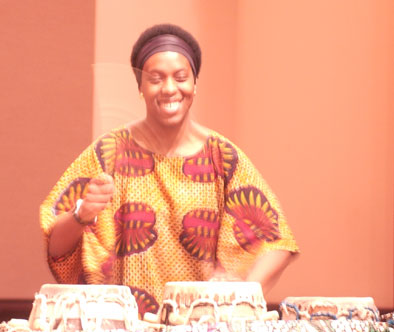 List Foundation Fellow M��lissa Edoh. |
Mélissa Edoh '02 (Political Science) held a performance of sabar drumming, concluding her IAP drumming class. Mélissa performed with her students, as well as with her LFFP faculty advisor and mentor, Patricia Tang and Lamine Touré.
Talía Kingsbury '01 (Mechanical Engineering and Creative Writing) published a chapbook, Origin/Destino and gave a reading in the fall.
As of 2003-2004, LFFP supports individual undergraduate creative work in the performing, literary, visual, and media arts. It is for MIT students exploring personal racial and cultural identity who are United States citizens or permanent residents.
Freshman Arts Seminar Advising Program
Freshman Arts Seminar Advising Program (FASAP) completed its first full year after a successful pilot in 2001-2002with four seminars led by Alan Brody (Theater), Michael Ouellette (Theater), Martin Marks (Music), and the team of Bill Arning and Kathy Goncharov (List Visual Arts Center). FASAP participants benefited from various arts excursions and special on-campus presentations in addition to study breaks and tutoring.
Mandatory events in the fall included: a FASAP student Arts Share; gallery tour of the Oni, Boston Center for the Arts Mills Gallery, and the Gallery at Green Street; Boston Modern Orchestra Project's "Chinese In America"; MIT List Visual Arts Center's After the Beginning and Before the End tour with Bill Arning; Artist-in-Residence Kasi Lemmons' lecture "Magic Realism and African-American Gothic Melodrama"; Marty at the Huntington Theater; a concert performance of A New England Seasonal with lecture by composer and MIT Lecturer Charles Shadle; Artist-in-Residence Ananya Chatterjea's talk titled, "Dancing India" and an end-of-term dinner.
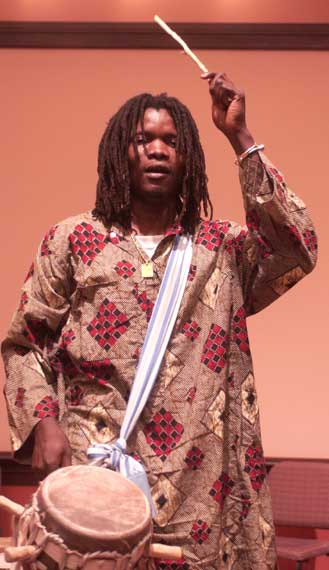 Artist-in-Residence Lamine Tour��. Photo by Ed Platt. |
Optional excursions and workshops throughout the year included: Sleater-Kinney concert; IAP photography workshop with Kevin Simmons '00*; Cantab 8x8 Poetry Slam with featured poet Jared Paul*; tour of MFA exhibitions, including Impressions of Light and screening of School of MFA Student Films*; Ballet Flamenco Sara Balas*; Spoken Word Workshop with local poet Letta Neely*; Senegalese Drumming Workshop with artist-in-residence Lamine Touré*; Connections Workshop and lecture with Clay Ward '97*, Visual Arts Program dinner featuring photography with presentations by lecturer Reiner Leist and students David Foxe and Peter Jamieson; and a Writing dinner with presentations by associate professor Junot Diaz, Lecturer Erika Funkhouser and senior lecturer Edward Barrett, students Michael Nagle and Sloan Kulper, and Nicole Vlado '02. (* denotes an event shared with the Arts Scholars Program)
Art Scholars
This program is in its fifth year and had 40 participants. Stewardship of this program has shifted from the Council for the Arts to Special Programs, as part of Student Programs. The new mission of the Arts Scholars Program is to make it a student-run collaboration. Participants formed a programming committee of eight students responsible for planning events for the year, including a public presentation of their work.
Events included: Aside Shows presents Toy Theater at the Zeitgeist Gallery; two general meetings; Fort Point Open Studios; "Art and Physics: Parallel Worlds" lecture by MIT Artist-in-Residence Donna Marcantonio*; Glass Lab demonstration* with advanced level students and Artist–in-Residence Peter Houk; Le Ballet National du Sénégal, 42nd Street*; Ken Schaphorst Ensemble*; Arts Scholars Arts Share; Apolkalypsis* at the BCA; DJ Krush* with lecture by Assistant Professor Ian Condry; Institute Professor John Harbison's Requiem at the Boston Symphony Orchestra; the MIT Festival Jazz Ensemble* with Aardvark Ensemble; Highway Ulysses* at the American Repertory Theater with Q&A panel discussion; All Balanchine, at the Boston Ballet with Associate Professor Thomas DeFrantz; Influence, Anxiety and Gratitude at the List Visual Arts Center and the MIT Visual Arts Program Open Studios Reception. (* denotes an event shared with the Freshman Arts Seminar Advising Program)
Art Reps
This initiative established a network of Arts Ambassadors in every dorm and living group. Dinners held once a term to provide Art Reps an opportunity to meet, discuss the program and learn about upcoming events and opportunities. Communication with the Art Reps is maintained in the form of a weekly email calendar of upcoming arts events at MIT.
Student Origami Exhibit
The first annual student competition was juried by origami specialists assistant professor Erik Demaine (EECS), Visiting Scientist Martin Demaine, and alumnae Elsa Chen, Anne LaVin, and Jeannine Moseley. The submissions were exhibited in the Office of the Arts from February-May 2003. The exhibit resulted in the revival of OrigaMIT, the origami student-activities club. Special Programs, MIT Japan Program, and the office of Erik Demaine cosponsored the competition.
Future Projects
Work has begun this year to establish the following projects that will be launched in 2003-2004:
Several initiatives are being worked on to serve the graduate student community interested in the Arts at MIT. The following projects are in the works: creating community across disciplines among graduate students who make art as a part of their graduate work; creating a structure that allows all graduate students to pursue the arts and to share their art; and creating a structure that allows all graduate students to gain more exposure to the arts as spectators. The Graduate Student Office has sponsored the first two projects. The Grad Arts Forum will be launched in fall 2003 and will be administered by Special Programs. The Graduate Artists Behind-the-Desk model will be administered by Graduate Students through the Graduate Student Office.
The annual Student Mural Competition will display a temporary student mural that will be digitally printed and hung in E15. A panel of judges (the Media Lab's executive director and senior research scientist Walter Bender, assistant professor Chris Csikszentmihályi, and professor Neil Gershenfeld, and LVAC staff Bill Arning and Tim Lloyd) will select the finalists. The residents of E15 will decide the winner in fall 2003.
Due to budget cuts, the opportunities for paid internships in the arts have diminished. Connections are being pursued in all of the MISTI Internships in the Arts programs. However, the lead-time in order to obtain funding is making this more challenging.
AiR Program
The MIT Artist-in-Residence (AiR) Program provides MIT students with opportunities to interact with nationally and internationally recognized artists through master classes, lecture-demonstrations, performances and workshops. By providing students with opportunities for direct involvement with artists in all of the arts, the AiR Program encourages creative thinking and personal expression and promotes cultural affirmation through the arts. The AiR Program enriches curricular innovation and promotes interdepartmental collaboration.
In support of the mission to bring internationally recognized artists to MIT, Special Programs has initiated communication with many artists and arts organizations in South Africa.
Artist in Residence Advisory Board
In consultation with the Advisory Board president Steve Memishian (G) '70, the associate provost for the arts Alan Brody, and the new director of Special Programs Michèle Oshima, the Advisory Board has been dissolved.
Named Residencies
The 2003 William L. Abramowitz Program brought cartoonist Art Spiegelman to campus in March. Spiegelman presented his lecture, "Comix 101" to the MIT community, and met with Comparative Media Studies (CMS) students. Preparation for this program included the distribution of Spiegelman's books Maus I, Maus II and Little Lit Folklore and Fairytale Funnies to Art Reps and CMS students.
The Katzenstein 2002-2003 residency was held by Kasi Lemmons, filmmaker and writer from November 6-8, 2002. The residency included a public presentation "Magic Realism and African-American Gothic Melodrama." CMS cosponsored the talk. The Office of the Arts and Counseling and Support Services sponsored public screenings of her films Eve's Bayou and Caveman's Valentine. The Committee on Campus Race Relations underwrote a luncheon with Lemmons and black students.
The Eugene McDermott Award recipient for 2002 was actor and activist Vinie Burrows. Burrows worked with associate professor Thomas DeFrantz of Theater Arts and the Black Theater Guild on the African American Living History Museum from February 25-27, 2003. Burrows collaborated with associate provost for the arts, Alan Brody, in conjunction with Women's Studies on the presentation of her one-woman show Rose McClendon: Black on the Great White Way presented on Thursday, March 6 with rehearsals during March 3-8, 2003. She met with students, staff and faculty from the Black Women's Alliance and Women's Studies.
The 2001-2002 Ida Ely Rubin residency recipient Paul Pfeiffer, digital video and mixed media installation artist was completed in the fall with Media Arts and Sciences. Pfeiffer completed a residency with the List Visual Arts Center following his Rubin residency and presented a solo exhibition at the List.
The 2002-2003 Rubin residency was completed in the spring with installation artist Cai Guo-Qiang. Cai collaborated with graduate students Bradley Pitts (Aeronautics Astronautics), Peng-kai Pan (Media Arts and Sciences), and Andrew G. Brooks (Electrical Engineering and Computer Science). The Center for Advanced Visual Studies (CAVS) generously provided an office for Cai and his assistant Jennifer Ma. A dinner with the Visual Arts Program faculty, staff, and graduate students was sponsored by the Rubin fund. Cai met with assistant professor Erik Demaine (Electrical Engineering and Computer Science) and professor Alex Slocum (Mechanical Engineering), visiting scientist Marty Demaine, CAVS fellow Seth Riskin, the "Computing Culture" lab and "Autonomous Art" class of assistant professor Chris Csikszentmihàlyi.
Department-Based Residencies
School of Architecture
The Architecture residency, including lecture series presentation, class visits, and student luncheon with Rajesh Mehta ('86) was cancelled due to family illness.
The Media Arts and Science residency (a MEAOW, Media Art—or Whatever) lecture and class visit to Professor Tod Machover's class "Music Aesthetics and Media Technology" sponsored by Assistant Professor Chris Csikszentmihályi with Rajesh Mehta ('86) was cancelled due to family illness.
School of Engineering
Electrical Engineering and Computer Science Assistant Professor Erik Demaine postponed the residency with MIT alumnus and sculptor George Hart until the fall of 2003.
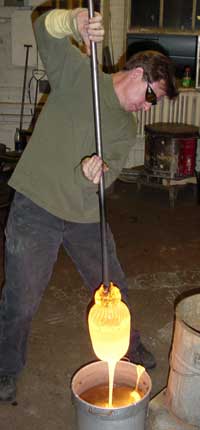 Artist-in-Residence Peter Houk. |
Materials Sciences and Engineering professor Michael Cima sponsored a residency to support Peter Houk's work at the MIT Glass Lab. Peter Houk, artistic director of the MIT Glass Lab, presented his work and that of four of his students in February 2003.
Mechanical Engineering professor Alex Slocum sponsored a residency with artist Mary Sherman. They cotaught a fall term course "Pathways to Peace", culminating with an exhibit of student work in the Wiesner Student Art Gallery in January 2003.
School of Humanities, Arts, and Social Sciences
Comparative Media Studies professor Henry Jenkins sponsored an IAP residency with cartoonist Scott McLoud. There was an IAP course on the graphic novel and a public talk given by Mr. McLoud.
Foreign Languages and Literatures lecturer Arundhati Banerjee sponsored a residency with actor and filmmaker Aparna Sen in the spring. IFilm screened several of Sen's films in advance of her residency which included class visits, a screening of her latest film, Mr. and Mrs. Iyer, followed by a talk including a surprise appearance by her daughter, Konkona Sensharma, the star of the film.
Music assistant professor Patricia Tang sponsored a residency with Senegalese master drummer Lamine Touré to work with the student performance group Rambax. Touré and his LFFP protégé Mélissa Edoh played for the opening of the McMillan-Stewart Lecture given by Senegalese author Ken Bugul. Professor Tang and Touré led a hands-on workshop on Senegalese drumming for FASAP and Arts Scholars. The music residency with musician, composer and instrument builder Rajesh Mehta ('86) was cancelled due to family illness.
The Women's Studies residency with Joy Harjo was postponed until April 2004.
School of Science
Physics Professor John Belcher sponsored a fall residency with kinetic sculptor Donna Marcantonio to assist with the new physics course 8.02 Teal. In the spring, Marcantonio taught a course on kinetic sculpture sponsored by the Edgerton Center and Physics. Marcantonio presented the lecture "Art and Physics: Parallel Worlds" to FASAP and the Arts Scholars.
Staffing News
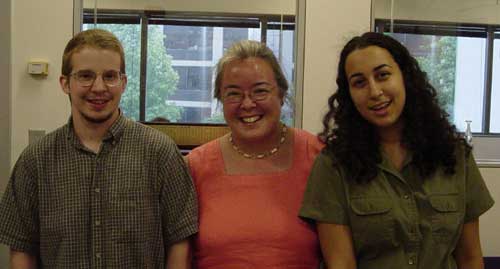 Special Programs staff: Nick Bozard '03, Michèle Oshima and Nicole Vlado '02. |
Michèle Oshima joined Special Programs in August 2002. As the new director of special programs, she upgraded and changed the staffing so that the program coordinator (formerly the senior staff assistant) is a recent graduate of MIT on a one-year contract. Senior staff assistant Meredith Cutler aided in the transition. The new program coordinator was Nicole Vlado '02 (Architecture), who joined Special Programs in September 2002. Nick Bozard '03 (Computer Science) has been hired to begin August 1, 2003. Student staff Mariana Baca '06, Patrick Boyle '06, Hilda Gutierrez '03, Peter Jamieson '03, Marc Rios '05, Madleina Scheidegger '03, and high school intern Candice Murphy were invaluable to the success of Special Programs.
Oshima won the following awards for 2002-2003:
- MIT Rallying for Education Project Community Service Award from the Black Student Union and La Unión Chicana por Aztlán "For your outstanding leadership and dedication to the community at large by participating in the March-on-Washington on April 1, 2003."
- James N. Murphy Award, which "honors an employee whose spirited contributions earned a place in the hearts of students."
- Sistah Summit Too: Black Butterfly Leadership Award June 2003 for "Youth Work," People to People, Boston, MA.
More information about Special Programs in the Office of the Arts can be found on the web at http://web.mit.edu/arts/special_programs/.